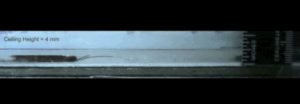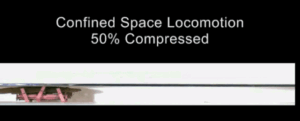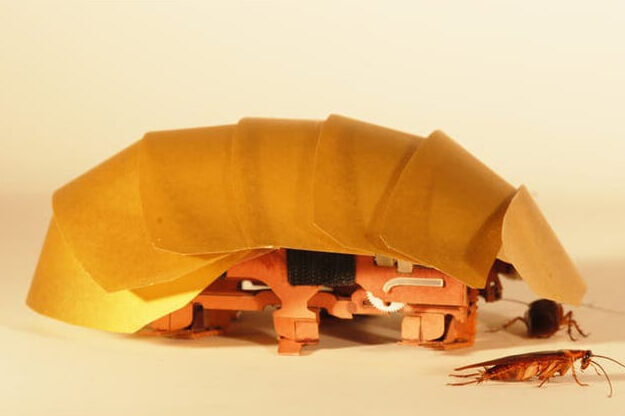An idea for a robot; Why are cockroaches so stubborn?
A group of researchers and robotics experts at Harvard University, inspired by the flexibility of the cockroach, built a small robot. This robot has an exoskeleton just like the cockroach, and because of its flexibility, it can easily pass through narrow grooves.
Have you ever accidentally stepped on a cockroach, only to be surprised to find that it is still alive? These insects face various obstacles and narrow gaps along their way, but they always easily pass through these obstacles and bottlenecks. Bees, on the other hand, always face obstacles such as leaves, branches, and petals, and their wings may hit these obstacles without being harmed. Now, researchers have somewhat figured out how these creatures bend, but don’t break.
The results of their research show well why cockroaches are so stubborn and have high resistance. Robert Full, a biologist at the University of California, and Kaushik Jayaram, a PhD student, conducted experiments on cockroaches to find out the secret of their tenacity. Full and Jayaram forced the insects to pass through very small and narrow cracks and tunnels while filming them in slow motion. They also placed 100 gram weights on different parts of the insect’s body and observed the insect’s reaction.

full and Jayaram found that the 9 mm beetle approached a 3 mm diameter opening and probed their entrance with their antennae. It then plunges its head, followed by its front legs into the gap, and finally the rest of its body. Meanwhile, the hind legs opened, but continued to push. Within a second, the creature reached the other side of the gap, safe and sound. Stacey Combes, a biologist at the University of California, Davis, says that the beetle’s ability to squeeze into tight spaces “far surpasses any other animal we know of, except the octopus.” But octopuses are not as fast as cockroaches or other arthropods. “Even crabs, spiders, and scorpions are easy to move around and indestructible,” Full says.
Jayaram and full paper, published this week, shows that the secret to the cockroaches’ hardiness lies in their tough yet flexible exoskeletons. This shell is made of hard but flexible plates and can transfer energy to the beetle’s legs. These plates are connected by elastic membranes and collapse when the insect is compressed. In this insect, there is a part that acts like a column of vertebrae and makes it able to move even when its legs are fully opened.
Biomechanics experts want to make more resistant robots by modeling the exoskeleton and hard and flexible wings of these insects. “These insects bend, but they don’t break,” says Robert Wood, a robotics expert at Harvard University. “We want to test these same features to see if our robots will be just as robust.”
The secret of the hardiness of cockroaches is in their external and yet flexible skeleton. A cockroach with a diameter of 9 mm can pass through a hole with a diameter of 3 mm.
In the past, most engineers designed rigid or sharp devices to avoid danger. A third method is also used in modern cars, by crumpling, they absorb the effect of the impact and sacrifice the structure to protect its occupants. David Hu, a mechanical engineer at the Georgia Institute of Technology, says: “Nature designed a tactic to protect itself that we don’t have… crumple up and move on.”
Andrew Mountcastle, a postdoctoral researcher at Harvard University, said during the Comparative and Hybrid Biology meeting in Portland that a similar combination of hard and soft components is observed in bees. This structure allows them to survive air obstacles. He filmed them using slow-motion videography and found that the bees’ wings bend when they hit an obstacle and then return to their original position. He also observed a patch of elastic protein called “Resilin” in these wings, which makes up about 65% of the wing. He and Kames hypothesized that the patch functions as a hinge.
To test his hypothesis, Mountscale found a way to put the bee on a rotating motor and hit the wing repeatedly. He showed that the bee’s wing repeatedly bent and returned to its original position. When Mountcastle removed the hinged part of the wing, the wing stopped bending and immediately fell apart. He and Kames also discovered that many insects have similar hinges, but wasp wings have a different design. The veins that support the wing of this bee are concentrated close to its body, so the wingtip is flexible and can pass over any obstacle.
The exoskeleton of the cockroach and the wings of insects both inspired the design of the robot. Jayaram created a 75 mm long robot called “CRAM” that has the same flexible exoskeleton as a cockroach. Its legs and spine work in compressed and non-compressed modes. The robot can be compressed to half its height, but still move 5 to 10 times faster than previously developed soft robots.


Mountcastle has now joined Jayaram and Wood to install hinged wings on an insect-sized flying robot called Robobee. “Designing them was not an easy task,” Mountcastle said at the Portland meeting. “They are not simple, linear hinges.” The group hopes to test the new robot in the real world by spring. Hu applauds the design of insect-inspired robots, saying, “It’s really cool to build a robot with potential harm in mind.”
if you enjoyed of our article also read about article about ultrasonic Roach Repeller Fake Or Real?!

